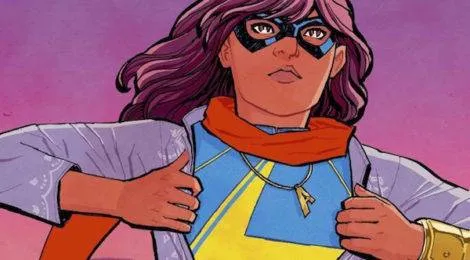
Fiction That Breaks Sexist and Racist Stereotypes
This content contains affiliate links. When you buy through these links, we may earn an affiliate commission.
This post is part of our International Women’s Day celebration. See all the posts here.
All over the world, women are breaking away from the neat societal boxes that the shackles of relativist culture or tradition have placed them in. It is truly a wonderful time to be alive when moving away from normative societal values, and breaking stereotypes is something that is happening all over the world. Whether it is India, where women are fighting to reclaim public spaces, or in the USA where women are protesting to reclaim their bodies, it is unique time to celebrate the fact that women are constantly opposing stereotypical ideas that surround their identities. In books, too, there have been a flurry of female characters who have broken stereotypes, and continue to be remembered as women who brought on a certain oppositional consciousness to fiction. Here are some women in books who are badass, and the stereotype they absolutely destroyed: I love reading books where motherhood is not oversimplified to be some out-of-body, perfect experience where a woman delivers a child and is immediately removed from her inherent flaws. I picked up White Oleander by Janet Fitch last year on a whim, and absolutely loved it – Ingrid is a self-centred, eccentric, and egotistic mother who often forgets about Astrid, her daughter who has a fear of abandonment. This fear does become reality at some point in the book, and we meet Claire – a mother-figure to Astrid – who loves her, but is depressed and unable to care for her.
I love reading books where motherhood is not oversimplified to be some out-of-body, perfect experience where a woman delivers a child and is immediately removed from her inherent flaws. I picked up White Oleander by Janet Fitch last year on a whim, and absolutely loved it – Ingrid is a self-centred, eccentric, and egotistic mother who often forgets about Astrid, her daughter who has a fear of abandonment. This fear does become reality at some point in the book, and we meet Claire – a mother-figure to Astrid – who loves her, but is depressed and unable to care for her.
 A few years ago, I read Em and the Big Hoom by Jerry Pinto. This is a story of a boy growing up in Mumbai, whose mother, Em, is afflicted with mental health issues. While the book is profoundly moving and the reader cannot help but marvel at Pinto’s vivid imagery of Mumbai, what is heart-rending is how Em’s manic-depressive character is written. Em is far from being the perfect mother, and the Mendes’ are far from being the perfect family, and this is the reason the story feels real – “Mad is an everyday, ordinary word. It is compact. It fits into songs. […] It can be everything you choose it to be: a mad whirl, a mad idea, a mad March day, a mad heiress, a mad mad mad mad world, a mad passion, a mad hatter, a mad dog…”
A few years ago, I read Em and the Big Hoom by Jerry Pinto. This is a story of a boy growing up in Mumbai, whose mother, Em, is afflicted with mental health issues. While the book is profoundly moving and the reader cannot help but marvel at Pinto’s vivid imagery of Mumbai, what is heart-rending is how Em’s manic-depressive character is written. Em is far from being the perfect mother, and the Mendes’ are far from being the perfect family, and this is the reason the story feels real – “Mad is an everyday, ordinary word. It is compact. It fits into songs. […] It can be everything you choose it to be: a mad whirl, a mad idea, a mad March day, a mad heiress, a mad mad mad mad world, a mad passion, a mad hatter, a mad dog…”
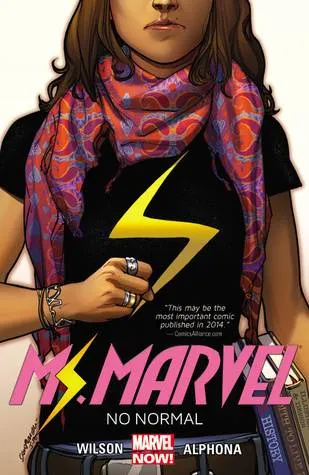 Avid readers know what ridiculous stereotype this is. Ms Marvel by G. Willow Wilson is an example. Kamala Khan is a Pakistani-American teenager who has shape-shifting abilities, following the aftermath of a seismic event. What follows is a one-of-a-kind story about a unique superhuman who is empowered and breaks every stereotype about Muslim women there is.
Avid readers know what ridiculous stereotype this is. Ms Marvel by G. Willow Wilson is an example. Kamala Khan is a Pakistani-American teenager who has shape-shifting abilities, following the aftermath of a seismic event. What follows is a one-of-a-kind story about a unique superhuman who is empowered and breaks every stereotype about Muslim women there is.
 The women in The Embroideries by Marjane Satrapi are also strong, vibrant and multi-dimensional Muslim characters who share outrageous and controversial stories about love, sex and their relationships with men.
The women in The Embroideries by Marjane Satrapi are also strong, vibrant and multi-dimensional Muslim characters who share outrageous and controversial stories about love, sex and their relationships with men.
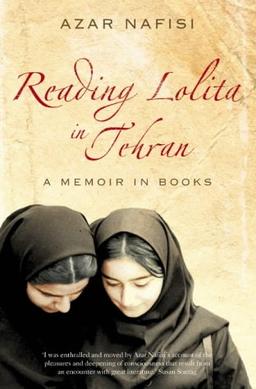 Azar Nafisi’s Reading Lolita in Tehran is another book where this stereotype is slayed. This is not a fictional work, and despite that, you cannot help but wonder about the lives of Nafisi and her students reading and discussing forbidden Western books every Thursday. As they pour their hearts into reading and discussing Jane Austen, F. Scott Fitzgerald, Henry James, and Vladimir Nabokov, the reader is left wondering if there’s a bigger act of revolution than reading a banned book.
Azar Nafisi’s Reading Lolita in Tehran is another book where this stereotype is slayed. This is not a fictional work, and despite that, you cannot help but wonder about the lives of Nafisi and her students reading and discussing forbidden Western books every Thursday. As they pour their hearts into reading and discussing Jane Austen, F. Scott Fitzgerald, Henry James, and Vladimir Nabokov, the reader is left wondering if there’s a bigger act of revolution than reading a banned book.
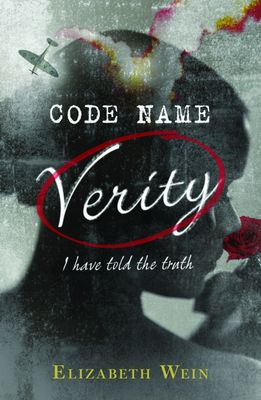 Patriarchy has managed to survive because it has, for years together, pitted women against women. And this is the reason why it is thought that female friendships are toxic, and they don’t survive the test of struggle and time. Code Name Verity by Elizabeth Wein is one of those books that manages to completely destroy this stereotype. The book is about two friends – a pilot and a spy – after a British spy-plane crashes in a fictional town called Ormaei in Nazi-occupied France in 1943. Verity is captured and forced to draft a confession about the British war effort, and she does this as she recounts the story of her and Maddie. This is one powerful book about some very badass women.
Patriarchy has managed to survive because it has, for years together, pitted women against women. And this is the reason why it is thought that female friendships are toxic, and they don’t survive the test of struggle and time. Code Name Verity by Elizabeth Wein is one of those books that manages to completely destroy this stereotype. The book is about two friends – a pilot and a spy – after a British spy-plane crashes in a fictional town called Ormaei in Nazi-occupied France in 1943. Verity is captured and forced to draft a confession about the British war effort, and she does this as she recounts the story of her and Maddie. This is one powerful book about some very badass women.
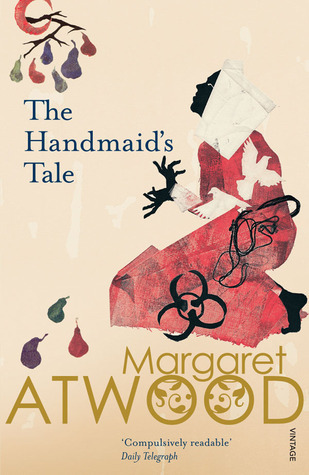 The Handmaid’s Tale by Margaret Atwood is my favourite book in the world because it shows us an imminent dystopia. Within the book, the relationship between Offred, the narrator, and Moira is uncanny. Moira and Offred have known each other since college; however, Moira has escaped Gilead and Offred admits to admiring her tenacity, rationality and devil-may-care attitude – “Moira was like an elevator with open sides. She made us dizzy. Already we were losing the taste for freedom, already we were finding these walls secure. In the upper reaches of the atmosphere you’d come apart, you’d vaporize, there would be no pressure holding you together.”
The Handmaid’s Tale by Margaret Atwood is my favourite book in the world because it shows us an imminent dystopia. Within the book, the relationship between Offred, the narrator, and Moira is uncanny. Moira and Offred have known each other since college; however, Moira has escaped Gilead and Offred admits to admiring her tenacity, rationality and devil-may-care attitude – “Moira was like an elevator with open sides. She made us dizzy. Already we were losing the taste for freedom, already we were finding these walls secure. In the upper reaches of the atmosphere you’d come apart, you’d vaporize, there would be no pressure holding you together.”
All over the world, women are breaking away from the neat societal boxes that the shackles of relativist culture or tradition have placed them in. It is truly a wonderful time to be alive when moving away from normative societal values, and breaking stereotypes is something that is happening all over the world. Whether it is India, where women are fighting to reclaim public spaces, or in the USA where women are protesting to reclaim their bodies, it is unique time to celebrate the fact that women are constantly opposing stereotypical ideas that surround their identities. In books, too, there have been a flurry of female characters who have broken stereotypes, and continue to be remembered as women who brought on a certain oppositional consciousness to fiction. Here are some women in books who are badass, and the stereotype they absolutely destroyed:
Mothers are perfect, saintly creatures who can do no wrong
 I love reading books where motherhood is not oversimplified to be some out-of-body, perfect experience where a woman delivers a child and is immediately removed from her inherent flaws. I picked up White Oleander by Janet Fitch last year on a whim, and absolutely loved it – Ingrid is a self-centred, eccentric, and egotistic mother who often forgets about Astrid, her daughter who has a fear of abandonment. This fear does become reality at some point in the book, and we meet Claire – a mother-figure to Astrid – who loves her, but is depressed and unable to care for her.
I love reading books where motherhood is not oversimplified to be some out-of-body, perfect experience where a woman delivers a child and is immediately removed from her inherent flaws. I picked up White Oleander by Janet Fitch last year on a whim, and absolutely loved it – Ingrid is a self-centred, eccentric, and egotistic mother who often forgets about Astrid, her daughter who has a fear of abandonment. This fear does become reality at some point in the book, and we meet Claire – a mother-figure to Astrid – who loves her, but is depressed and unable to care for her.
 A few years ago, I read Em and the Big Hoom by Jerry Pinto. This is a story of a boy growing up in Mumbai, whose mother, Em, is afflicted with mental health issues. While the book is profoundly moving and the reader cannot help but marvel at Pinto’s vivid imagery of Mumbai, what is heart-rending is how Em’s manic-depressive character is written. Em is far from being the perfect mother, and the Mendes’ are far from being the perfect family, and this is the reason the story feels real – “Mad is an everyday, ordinary word. It is compact. It fits into songs. […] It can be everything you choose it to be: a mad whirl, a mad idea, a mad March day, a mad heiress, a mad mad mad mad world, a mad passion, a mad hatter, a mad dog…”
A few years ago, I read Em and the Big Hoom by Jerry Pinto. This is a story of a boy growing up in Mumbai, whose mother, Em, is afflicted with mental health issues. While the book is profoundly moving and the reader cannot help but marvel at Pinto’s vivid imagery of Mumbai, what is heart-rending is how Em’s manic-depressive character is written. Em is far from being the perfect mother, and the Mendes’ are far from being the perfect family, and this is the reason the story feels real – “Mad is an everyday, ordinary word. It is compact. It fits into songs. […] It can be everything you choose it to be: a mad whirl, a mad idea, a mad March day, a mad heiress, a mad mad mad mad world, a mad passion, a mad hatter, a mad dog…”
Women from Muslim cultures have no agency
 Avid readers know what ridiculous stereotype this is. Ms Marvel by G. Willow Wilson is an example. Kamala Khan is a Pakistani-American teenager who has shape-shifting abilities, following the aftermath of a seismic event. What follows is a one-of-a-kind story about a unique superhuman who is empowered and breaks every stereotype about Muslim women there is.
Avid readers know what ridiculous stereotype this is. Ms Marvel by G. Willow Wilson is an example. Kamala Khan is a Pakistani-American teenager who has shape-shifting abilities, following the aftermath of a seismic event. What follows is a one-of-a-kind story about a unique superhuman who is empowered and breaks every stereotype about Muslim women there is.
 The women in The Embroideries by Marjane Satrapi are also strong, vibrant and multi-dimensional Muslim characters who share outrageous and controversial stories about love, sex and their relationships with men.
The women in The Embroideries by Marjane Satrapi are also strong, vibrant and multi-dimensional Muslim characters who share outrageous and controversial stories about love, sex and their relationships with men.
 Azar Nafisi’s Reading Lolita in Tehran is another book where this stereotype is slayed. This is not a fictional work, and despite that, you cannot help but wonder about the lives of Nafisi and her students reading and discussing forbidden Western books every Thursday. As they pour their hearts into reading and discussing Jane Austen, F. Scott Fitzgerald, Henry James, and Vladimir Nabokov, the reader is left wondering if there’s a bigger act of revolution than reading a banned book.
Azar Nafisi’s Reading Lolita in Tehran is another book where this stereotype is slayed. This is not a fictional work, and despite that, you cannot help but wonder about the lives of Nafisi and her students reading and discussing forbidden Western books every Thursday. As they pour their hearts into reading and discussing Jane Austen, F. Scott Fitzgerald, Henry James, and Vladimir Nabokov, the reader is left wondering if there’s a bigger act of revolution than reading a banned book.
Female friendships are often toxic
 Patriarchy has managed to survive because it has, for years together, pitted women against women. And this is the reason why it is thought that female friendships are toxic, and they don’t survive the test of struggle and time. Code Name Verity by Elizabeth Wein is one of those books that manages to completely destroy this stereotype. The book is about two friends – a pilot and a spy – after a British spy-plane crashes in a fictional town called Ormaei in Nazi-occupied France in 1943. Verity is captured and forced to draft a confession about the British war effort, and she does this as she recounts the story of her and Maddie. This is one powerful book about some very badass women.
Patriarchy has managed to survive because it has, for years together, pitted women against women. And this is the reason why it is thought that female friendships are toxic, and they don’t survive the test of struggle and time. Code Name Verity by Elizabeth Wein is one of those books that manages to completely destroy this stereotype. The book is about two friends – a pilot and a spy – after a British spy-plane crashes in a fictional town called Ormaei in Nazi-occupied France in 1943. Verity is captured and forced to draft a confession about the British war effort, and she does this as she recounts the story of her and Maddie. This is one powerful book about some very badass women.
 The Handmaid’s Tale by Margaret Atwood is my favourite book in the world because it shows us an imminent dystopia. Within the book, the relationship between Offred, the narrator, and Moira is uncanny. Moira and Offred have known each other since college; however, Moira has escaped Gilead and Offred admits to admiring her tenacity, rationality and devil-may-care attitude – “Moira was like an elevator with open sides. She made us dizzy. Already we were losing the taste for freedom, already we were finding these walls secure. In the upper reaches of the atmosphere you’d come apart, you’d vaporize, there would be no pressure holding you together.”
The Handmaid’s Tale by Margaret Atwood is my favourite book in the world because it shows us an imminent dystopia. Within the book, the relationship between Offred, the narrator, and Moira is uncanny. Moira and Offred have known each other since college; however, Moira has escaped Gilead and Offred admits to admiring her tenacity, rationality and devil-may-care attitude – “Moira was like an elevator with open sides. She made us dizzy. Already we were losing the taste for freedom, already we were finding these walls secure. In the upper reaches of the atmosphere you’d come apart, you’d vaporize, there would be no pressure holding you together.”- To Reach The Farthest Sea
- Double Erasure: Latin American Women Writers
- 5 Books by Queer Women
- Books for the Jewish Feminist
- 5 Latin American Women Authors to Read Right Now
- Welcome to International Women’s Day 2017 at Book Riot
- Must-Read Black Feminist Literature
- Romance Without Feminism is No Longer an Option
- Feminist Middle Grade Books
- Madonna and the Madwoman: On the Women of Jose Rizal’s Classic Noli Me Tangere



